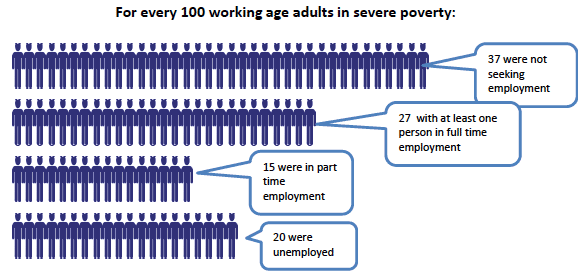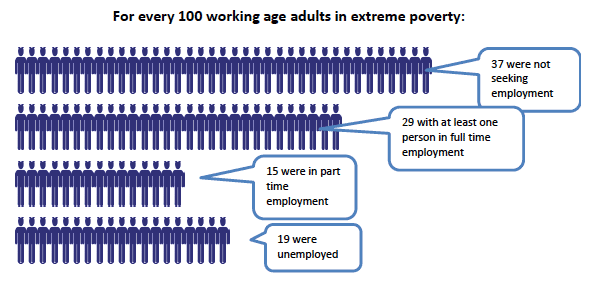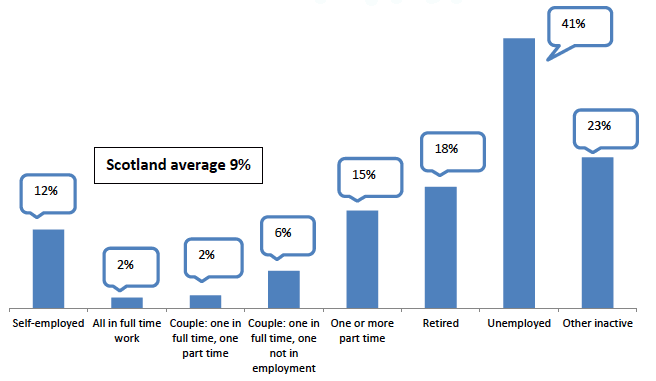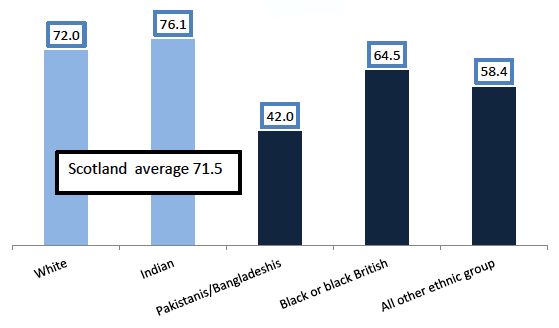Severe Poverty in Scotland
This report investigates the extent of severe and extreme poverty and how it has changed over time for different population groups, in the context of a decade when relative poverty has been falling in Scotland.
SECTION D: FACTORS INFLUENCING THE RISK OF SEVERE AND EXTREME POVERTY
Introduction
This section considers the extent to which the following factors influence the risk of severe and extreme poverty:
1. Employment status
2. Family type
3. Adult disability
4. Age of mother and child poverty
5. Family size
6. Ethnic group
The factors identified below are dependent on characteristics available in the FRS, and that can be linked to the household, but their selection was also based on analysis published elsewhere on the drivers of poverty[20] [21]. However, the FRS does not contain any data on broader structural issues - the structure and accessibility of the labour market, the extent to which high quality affordable housing is available, the extent to which energy markets are providing low cost home energy for poorer consumers, and the cost of living more broadly. These are likely to be the key drivers of severe and extreme poverty in the UK over recent years.
This analysis uses three year pooled FRS data. It uses the poverty thresholds to investigate risk factors, as these provide larger sample sizes.
1. Employment status
Employment significantly reduces the risk of severe and extreme poverty. However, in-work poverty remains a problem for those in severe and extreme poverty. More than four in ten working age adults and more than half of children in severe and extreme poverty lived in working households in 2012/13.
The nature of poverty has changed in Scotland and in the UK. While employment remains the best route out of poverty, the last decade has seen a steady increase in working poverty. In 2012/13, the majority[22] of children and working age adults living in poverty in Scotland were in 'working' households[23].
The graphic below shows the employment status of working age adults in severe poverty.

The graphic makes clear that over half of working age adults in severe poverty were not in employment in 2012/13 - either unemployed or not actively seeking employment. Note, however, that over four in ten of this group (43 per cent) were in households where at least one adult was in employment, and 27 per cent were in households where at least one adult was in full time employment.
The composition of working age adults in extreme poverty mirrors this picture - see graphic below - with very similar numbers in employment, unemployed, and not seeking employment.

Analysis of the FRS shows that households not in employment have a higher risk of severe poverty and extreme poverty; this is especially the case for unemployed households. However, while households in employment are significantly less likely to be in severe or extreme poverty, a significant percentage of people in severe and extreme poverty live in households where at least one adult is in employment. For example, in 2012/13:
- 10 per cent of working age adults (330,000) lived in severe poverty households, of which 43 per cent of lived in working households.
- 5 per cent of working age adults (170,000) lived extreme poverty households, of which 44 per cent lived in working households.
Chart 9 below shows the risk of severe poverty for working age adults by employment status.
Chart 9: Risk of severe poverty by employment status

Source HBAI 2010/11, 2011/12 and 2012/13, DWP
The chart makes clear that the risk of severe poverty increases significantly as household work intensity decreases, and particularly when households move into unemployment. The risk of severe poverty for unemployed households was 41 per cent, compared with 2 per cent for working age households with at least one person in full time employment.
Table 5 below shows the percentage of people in relative, severe and extreme poverty who are in employment. For families with children in severe poverty, 55 per cent were in some form of employment, and 39 per cent had at least one adult in full time employment. For families with children in extreme poverty, 60 per cent were households with at least adult in employment, and 50 per cent had at least one adult in full time employment. However, this does not account for family type or hours worked and pay rates. The higher percentage of children in extreme poverty households in employment and full time employment reflects households where one adult is in full time employment while the other is not in employment. Analysis for the UK shows around two-thirds (65 per cent) of all parents in low income who enter work move out of low income. This varies by work pattern: 46 per cent move out of low income for part time work and 80 per cent for full time work.[24]
Table 5: Per cent of households in poverty in employment
| Below 60% threshold | Below 50% threshold | Below 40% threshold | |
|---|---|---|---|
| Working age adults in households with at least one adult in employment | 45% | 43% | 44% |
| Working age adults in households with at least one adult in full time employment | 30% | 27% | 29% |
| Children in households with at least one adult in employment | 53% | 55% | 60% |
| Children in households with at least one adult in full time employment | 39% | 39% | 50% |
| People in households with at least one adult in employment | 39% | 39% | 42% |
| People in households with at least one adult in full time employment | 27% | 25% | 29% |
Source HBAI 2010/11, 2011/12 and 2012/13, DWP
While being in employment reduces the risk of being in poverty, being in full-time employment significantly reduces the risk of poverty. For working age households, both with and without children, where at least one adult is in full time employment, the risks of severe poverty and extreme poverty were small. However, for those in severe and extreme poverty, over 40 per cent were in working households.
The risks of severe and extreme poverty are increased as household work intensity decreases. Full time employment by at least one adult in the household significantly reduces the risk of relative poverty, severe poverty and extreme poverty. This is reduced further as a household moves towards full working - with one adult in full time employment and the other in at least part time employment[25]. The risk of relative poverty, severe poverty and extreme poverty increases quickly for working age households where adults are in part time employment only.
For households in employment, those in self-employment had the highest risk of severe poverty, and extreme poverty[26].
Households not in employment may be so for differing reasons, and the reason for not being in employment determines the risk of severe and extreme poverty. For working age households with a retired head, the risk of relative poverty, severe poverty, and extreme poverty is lower than that for households in part time employment only (but higher than for households in full time employment). Working age households who are unemployed had the greatest the risk of low income, severe poverty and extreme poverty, and this was significantly higher than for any other households.
2. Family type
While single parent families have the greatest risk of relative poverty, single adult households without children had the greatest risk of severe and extreme poverty.
Table 6 below, is based on three years of pooled data, and considers the risk of relative, severe and extreme poverty by family type. This shows that, while single parent households had the highest risk of relative poverty, single adult households without children had the highest risk of severe poverty and extreme poverty. Single parent households and single pensioner households also had a higher risk of severe poverty, although there was no difference in the risk of extreme poverty. Couples without children and pensioner couples had the lowest risk of severe poverty.
Table 6: Risk of poverty by family type
| Below 60% threshold | Below 50% threshold | Below 40% threshold | |
|---|---|---|---|
| Pensioner: Couple | 13% | 6% | 2% |
| Pensioner: Single | 18% | 10% | 4% |
| Couple: Dependent children | 13% | 7% | 3% |
| Single parent: Dependent children | 25% | 11% | 4% |
| Couple: no children | 8% | 6% | 4% |
| Single: No children | 19% | 14% | 8% |
| TOTAL | 15% | 9% | 4% |
Source HBAI 2010/11, 2011/12, and 2012/13, DWP
For single adults without children, the risk of severe and extreme poverty differs by age and gender. Single males without children aged between 30 and 49 years had a higher risk of severe poverty than single females without children in this age group. The risk of severe poverty is not significantly different for younger (aged less than 30) single males and females without children.
For single adults without children in employment, the increases in the personal allowance have helped to increase earnings. However, this only applies to those adults earning more than the tax threshold. Since 2001/02 there has been a rise in the number of working age adults without children in in-work poverty, and no change in the number in workless families without children.
For unemployed single adult households without children, basic out-of-work benefits are less generous than for families with children. Up to 2010/11, some benefits relating to households with children were uprated faster than other benefits, meaning smaller increases in benefit income for single adult households compared with other households. Further, unemployment rates have been higher for younger age groups. With the onset of recession in 2008, unemployment rose for all age groups. But since 2010, the only subsequent rise in unemployment has been among young adults. By mid-2012, the unemployment rate for under-25s (unemployed people as a proportion of those either in work or unemployed) was 21%. The rate for over-25s was 6%.[27]
The Joseph Rowntree Foundation's Minimum Income Standard analysis[28] reveals that basic out-of-work benefits provide well under half of the minimum income (net of rent and council tax) required for an adult with no children, and around 60 per cent of the requirements of families with children, and 95 per cent of the budget for pensioners.
Of families with children, single parent households have a significantly higher risk of low income than couple families. There is a strong association between being the child of a lone parent and the parent not being in employment. Lone parents can face significant barriers to finding employment that is appropriate to their circumstances and to accessing and paying for the support required to stay in employment[29].
Lone parents face additional barriers to the labour market, such as lack of affordable and flexible childcare which pushes them into part time work, with part time employment more likely to be low paid than full time employment[30]. Oxfam research[31] at the UK level has shown single mothers are more likely to take insecure low paid employment which fits around their caring responsibilities.
For couples with children, mothers are still less likely to be in work and much less likely to be in full-time work than women without children, or men. The UK is behind the top performers in the following three areas: mothers of children aged three to five; single mothers; and mothers with three or more children.[32]
The combination of low work intensity and low pay for many parents results in severe poverty which is difficult to move out of until children do not need childcare (typically secondary school age). Analysis of the Growing Up in Scotland (GUS) dataset highlights that, for families, childcare is a significant factor in securing employment[33]. Such findings suggest that parents are likely to use childcare in order to work, and that when childcare is not available or affordable, this acts as a barrier to seeking employment.[34]
3. Adult disability
While households with a disabled adult have a greater risk of relative poverty, there are no significant differences in the risk of severe and extreme poverty.
Households which include a disabled adult[35] have a higher risk of relative poverty than those that do not. One in five people living in households with a disabled adult are in relative poverty, compared with one in seven for households that do not have a disabled adult.
Table 7 compares the proportion of households which include a disabled adult with households with no disabled adults, in relation to their risk of severe and extreme poverty. In 2012/13, one in ten people living in households containing a disabled adult was in severe poverty, and one in twenty were in extreme poverty. The risks of severe or extreme poverty were broadly similar for households which include a disabled adult and those that do not.
Table 7: Risk of Severe and extreme Poverty 2012/13: Disability of adult
| Below 60% threshold | Below 50% threshold | Below 40% threshold | |
|---|---|---|---|
| Family with an adult with disability | 20% | 11% | 4% |
| Family with no adults with a disability | 14% | 9% | 5% |
| Total | 16% | 10% | 4% |
Source HBAI 2012/13, DWP
Note: In 2012/13 the Family Resources Survey (FRS) disability questions were revised to reflect new harmonised standards. Comparisons between the 2012/13 figures in this report and past data should be made with caution, as they may be affected by the change in the definition of disability. For this reason, the table above is based on 2012/13 FRS data only
One of the main reasons that disabled working-age adults are more likely to be in low-income households is because they are less likely to be in work. The employment rate for disabled people remains at around half of that for people without disabilities. Within this, there are significant differences. For people with work-limiting disabilities[36] only, the employment rate in 2012 was 60.5 per cent. For people who are disabled in terms of the Disability Discrimination Act (DDA) and had work limiting disabilities, the employment rate was 28 per cent. These figures compare with nearly eight in ten people who have no disability. There is also a higher incidence of low paid employment for people with disabilities.[37]
Households with a disabled adult who are not receiving disability benefits[38] face a higher risk of low income than those who do receive disability benefits[39].
4. Age of mother and child poverty
For families with children, age of the mother affects the risk of poverty. The risk of relative poverty, severe poverty and extreme poverty where the mother is aged less than 25 is nearly double that for any other age group.
Analysis of the FRS, using three year pooled data, suggests that the risk of children living in poverty is influenced by the age of the mother.[40]. The risk of relative poverty increases significantly if the mother is less than 25 years old. For families where the mother is over 25, the risk of relative poverty is similar across the age bands. This is also the case for the risk of severe poverty and extreme poverty. This pattern holds whether we look at all individuals in families with children, only children, or family units.
For families with children, the risk of relative poverty where the mother is aged less than 25 is nearly double that for any other age group. Young mothers have a 38 per cent risk of relative poverty; a 17 per cent risk of severe poverty, and a 9 per cent risk of extreme poverty.
Table 8: Risk of severe and extreme poverty: Children 2010/11 - 2012/13: Maternal age
| Age of mother | Below 60% threshold | Below 50% threshold | Below 40% threshold |
|---|---|---|---|
| <25 | 38% | 17% | 9% |
| 25-29 | 18% | 10% | 4% |
| 30-34 | 18% | 6% | 3% |
| 35-39 | 16% | 9% | 3% |
| 40-44 | 14% | 7% | 3% |
| 45-49 | 12% | 7% | 3% |
| 50+ | 16% | 10% | 5% |
| Total | 17% | 8% | 3% |
Table 9: Risk of severe and extreme poverty: Families with children 2010/11 - 2012/13: Maternal age
| Age of mother | Below 60% threshold | Below 50% threshold | Below 40% threshold |
|---|---|---|---|
| <25 | 37% | 18% | 9% |
| 25-29 | 17% | 10% | 4% |
| 30-34 | 16% | 6% | 2% |
| 35-39 | 15% | 8% | 3% |
| 40-44 | 13% | 7% | 3% |
| 45-49 | 11% | 6% | 2% |
| 50+ | 16% | 10% | 5% |
| Total | 16% | 8% | 3% |
Source: HBAI dataset DWP
This analysis confirms that by Save the Children, who found (based on 2009 FRS data) that children living with adults aged 25 and under were at higher risk of severe poverty: 30 per cent of children in this group were living in severe poverty - although they account for only 14 per cent of children in severe poverty.
Younger mothers have had less time to gain progression in their employment, and are also more likely to have younger children, which impacts on their ability to take up employment opportunities. Many mothers also choose to take time out of employment while their children are very young. This means for these households, many will only have one income, increasing the risk of low income.
5. Family size
The risks of relative poverty and severe poverty increase sharply if a family has three or more children. However, the risk of extreme poverty is broadly similar in smaller family sizes, and it is lower than that for households without children.
Table 10 shows that the risks of relative poverty and severe poverty increase sharply if a family has three or more children. However, the risk of extreme poverty is broadly similar in smaller family sizes, and it is lower than that for households without children. There is little difference in the risk of relative poverty, severe poverty and extreme poverty for working age households without children and those with one and two children.
Table 10: Risk of severe and extreme poverty: Number of children
| Number of children | Below 60% threshold | Below 50% threshold | Below 40% threshold |
|---|---|---|---|
| 0 | 14% | 9% | 5% |
| 1 | 14% | 8% | 3% |
| 2 | 15% | 7% | 3% |
| 3 | 23% | 11% | 2% |
| More than 3 | 24% | 12% | 3% |
Source: HBAI Dataset 2010/11, 2011/12, 2012/13 DWP
Couple families with children are more likely to be in employment. Of those in poverty, couple households with children below the poverty threshold were more likely to be in employment than those without children[41]. The combination of earned income and tax credit and benefit income, while below the relative poverty threshold, moves families with children out of extreme poverty.
Again, access to flexible and affordable childcare is a particular issue for larger families, which acts as a barrier to taking up employment opportunities. While 50 per cent of households with children in extreme poverty contained at least one adult in employment, the pattern was for one adult in employment with the other adult not in employment. The risk of extreme poverty fell significantly for couple families with children when both adults were in employment with one in full time employment.
6. Ethnic Group
Minority ethnic groups have a higher risk of severe and extreme poverty than the white British population.
Table 13 shows the risk of severe and extreme poverty, using three years of pooled data, for ethnic groups in Scotland. Particular ethnic groups are grouped together in order to enable sufficient numbers for reporting.
Table 11: Risk of severe and extreme poverty 2010/11 - 2012/13: Ethnicity
| White - British | White - other | Asian or Asian British | Mixed, Black, Black British, Chinese and Other | Total | |
|---|---|---|---|---|---|
| 60% threshold | 14% | 19% | 22% | 27% | 15% |
| 50% threshold | 8% | 13% | 15% | 21% | 9% |
| 40% threshold | 4% | 8% | 6% | 15% | 4% |
Source: HBAI Dataset 2010/11, 2011/12, 2012/13 DWP
The ethnic groupings set out here show higher risks of severe poverty for minority ethnic groups than the white British population. However, the risks of extreme poverty vary across the groups set out. The 'Mixed, Black, Chinese and other ethnic' grouping has the highest risk of relative poverty (27%), severe poverty (21%) and extreme poverty (15%), while the White British group has the lowest risk (14%, 8% and 4%).
Chart 10 below shows the differences in employment rates for Scotland the year to March 2013[42].
Chart 10: Scotland: Employment rate by ethnic grouping 2012/13

Source: Annual Population Survey 2013
All ethnic groups considered here, with the exception of Indians, have significantly lower employment rates than those of White ethnicity. Pakistani/Bangladeshi groups have particularly low employment rates.
Even where minority ethnic groups were in employment, evidence suggests this is more likely to be low paid, and while the rates of low paid employment vary between minority ethnic groups, all were higher than the white ethnic group. For those in work, the greater prevalence of low pay means families in employment remain in poverty.[43]
Research[44] into the links between poverty and ethnicity has shown, at UK level, that differences in age structure, family type and family work status together account for around half of the 'excess' income poverty rates suffered by minority ethnic groups compared with white British people. Of these three factors, work status had the biggest effect for the Bangladeshi and Pakistani population. Family type had the biggest effect for the black Caribbean population, with both family type and work status having an effect for the black African population: the prevalence of lone parents within these two ethnic groups was an important factor.
However, differences in age structure, family type and family work status do not account for the other half of the 'excess' income poverty rates among minority ethnic groups, which must therefore be due to other factors.
Contact
Email: Stephen Smith
There is a problem
Thanks for your feedback